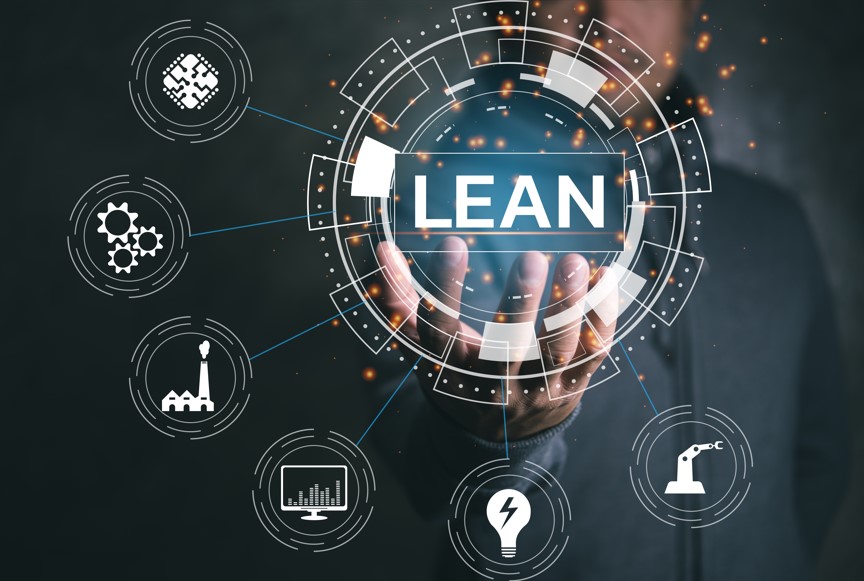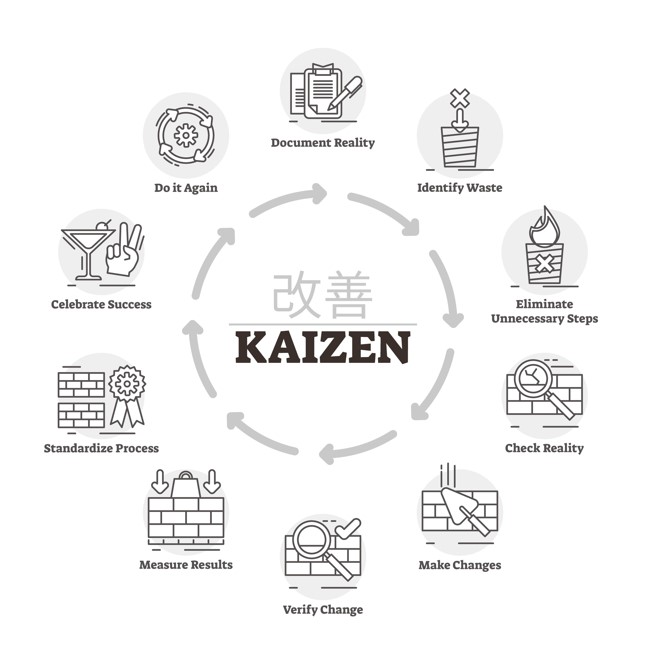Lean manufacturing helps businesses work more efficiently by using simple yet highly effective tools and techniques to keep your operations running smoothly and reduce waste.
With lean manufacturing, you can implement more cost-effective measures and streamline your manufacturing process. In the long run, this will improve your chances of success and help you stay ahead of your competitors.
So, if you want to learn more about the most common lean manufacturing tools and techniques, let’s get straight into it.

Understanding Lean Manufacturing
Lean manufacturing is a way of improving how things are made by eliminating waste and making processes faster. This idea started with the Toyota Production System (TPS) and focuses on providing your customers with the most value by making production smoother and more cost-effective. Ultimately, the goal is to create more value with fewer resources.
There are five main principles in lean manufacturing to keep in mind:
- Value: This places a focus on what your customers value. Therefore, you’ll need to ensure that everything in the manufacturing process contributes to this value.
- Value stream: The value stream looks at the entire process of making a product, from start to finish. That way, you can remove any waste or steps that don’t add any value.
- Flow: Once the waste has been removed, you’ll need to make sure the production process moves smoothly without delays to help speed up production.
- Pull: Instead of ‘pushing’ products through the production process to inventory, you should focus on making products based on customer demand. In essence, this means producing only what is needed.
- Perfection: Lean manufacturing is all about continuous improvement. So, you should always look for opportunities to reduce waste and encourage process improvement.
There are several tools, principles, and techniques that you can use to help achieve the goals of lean manufacturing. While some tools have more general applications, others play a specific role, such as waste reduction. Let’s get into the most commonly used tools for the manufacturing process.
Value Stream Mapping (VSM)
Value stream mapping is a lean manufacturing tool you can use to visualize the entire process of producing a product – from raw materials to when it reaches the customer. Generally, the goal is to identify waste, bottlenecks, or inefficiencies that slow down production.
By mapping out every step of the process, it becomes much easier to pinpoint areas for improvement and streamline the flow of materials and information.
The 5S System
The 5S system is a method that is used to keep workplaces clean, organized, efficient, and productive. It helps to improve how things are done in a way that makes work easier and faster.
The 5 steps include:
1. Sort (Seiri)
First, you’ll want to get rid of anything in the workplace that isn’t needed. This clears up space and ensures only necessary items are around, which makes it easier to find things when you need them.
2. Set in order (Seiton)
Next, you’ll want to organize everything so that it’s easy to find and use. That way, things are easier to locate. In turn, it can save time and reduce the possibility of mistakes.
In essence, everything should have a designated space.
3. Shine (Seiso)
Shining is exactly what it sounds like – cleaning your workspace and equipment to keep them in good condition. A clean workspace is not only safer, but it will also allow your employees to spot problems early. For example, this may include a broken part or a dirty machine. Ultimately, this ensures overall equipment effectiveness.
4. Standardize (Seiketsu)
This involves setting clear rules for how things should be cleaned and organized, and ensuring all your employees follow these rules. As a result, the workspace will become more consistent and efficient.
5. Sustain (Shitsuke)
The last step is to keep the 5S system going by making a habit out of it. Without this step, the system may fall apart. So, be sure to prioritize regular check-ups and maintenance schedules.
Kaizen
Kaizen, which translates to ‘continuous improvement’, is essential for lean management. It’s the practice of making small, incremental improvements to your manufacturing processes over time.
Generally, Kaizen encourages all your employees to look for ways to improve manufacturing workflows and reduce waste in their daily work. This way, you can achieve operational excellence by implementing continuous and manageable improvements.

Kanban
The Kanban system is a pull-based scheduling system that helps you manage your inventory and production flow. The idea is to produce only what is needed – and when it’s needed – to reduce waste and avoid overproduction.
Visual cues (like those included in HighGear’s enterprise task management system) can signal to you when to replenish your stock or move on to the next step in the production line. In turn, you can streamline the continuous flow of materials and optimize your inventory levels.
Takt Time
Takt Time is the pace at which products need to be produced to meet customer demands. When you align production speed with demand, Takt Time can help eliminate the possibility of both over and underproduction. As a result, you can optimize your efficiency.
Takt Time is calculated by dividing the available production time by customer demand. For example, if you have 480 minutes of production time per day and a demand for 240 units, the Takt Time is two minutes per unit.
Total Productive Maintenance (TPM)
TPM is an approach that is focused on maintaining your equipment and keeping it in peak condition. The goal is to minimize downtime and eliminate breakdowns.
By keeping your machines running smoothly and reliably, TPM improves the overall efficiency of your systems. It also relies heavily on the use of overall equipment effectiveness (OEE) to measure how well your equipment is performing.
Jidoka
Jidoka (also known as autonomation) emphasizes the importance of stopping production when a problem occurs. This helps prevent the production of defective or faulty items.
Typically, Jidoka is often used together with automated systems and sensors. These systems can detect issues in real time and will trigger an alert to stop production until the problem is resolved. With this system in place, faulty items are not passed on to the next stage of the manufacturing process.
Poka-Yoke
Poka-Yoke focuses on eliminating human error by designing processes that make mistakes impossible. For instance, sensors, guides, or visual cues are typically used in Poka-Yoke systems to ensure that processes are followed correctly.
For instance, in electronics manufacturing, a Poka-Yoke system may include a sensor that prevents you from inserting an incorrectly sized component into a circuit board.
Root Cause Analysis (RCA)
RCA is used to identify the underlying cause of problems and prevent them from happening again. It involves asking ‘why’ until the root cause is discovered, or it involves a visual tool that categorizes potential causes (a fishbone diagram).
Lean Manufacturing And Digital Transformation
Lean manufacturing thrives with Industry 4.0 technologies like AI, the Internet of Things (IoT), and big data. These digital solutions can improve lean practices by enabling real-time tracking, automated workflows, minimized waste, and more.
For example, digital Kanban systems can streamline things like inventory management, while predictive maintenance powered by IoT reduces downtime by preventing equipment failures.
HighGear’s no-code workflow automation platform is a prime example of how your business can leverage digital transformation to boost lean manufacturing. Without the need for extensive IT programming, you can simplify business process management (BPM) and improve transparency in your operations. Plus, our platform supports integration with your existing legacy systems.
FAQs
What are the tools for lean manufacturing?
There are many lean manufacturing tools that you can use within your organization. The most common tools include:
- 5S
- Kanban
- Kaizen
- Value stream mapping (VSM)
What are the 7S of lean tools?
The 7S model extends the 5S framework but includes two extra elements that further emphasize continuous improvement and employee involvement. These additional elements are:
- Safety: This focuses on creating a safe work environment by identifying and addressing potential hazards in the workplace.
- Skills: You’ll want to develop and maintain your employees’ necessary skills. This includes encouraging ongoing training and improvement to maintain a skilled workforce.
Why are lean tools important?
Lean manufacturing tools are incredibly important. They help to eliminate waste, ensure efficient processes, reduce costs, improve quality, and increase customer satisfaction. Ultimately, this fosters a manufacturing culture of continuous improvement.
What are the 5S tools of lean manufacturing?
The 5S tools of lean manufacturing include:
- Sort
- Set in order
- Shine
- Standardize
- Sustain
What is the purpose of lean manufacturing?
The purpose of lean manufacturing is to eliminate waste, improve product quality, and reduce production costs. This is all done with the goal of improving efficiency and meeting your customer demand more effectively.
Conclusion
If you want to integrate lean manufacturing tools and techniques into your organization as seamlessly as possible, you’ll need a little extra support. Of course, the easiest way to do this is by using comprehensive workflow automation software. So, if you want to learn more about HighGear and its features, like the workflow assistant, be sure to book a demo today!
